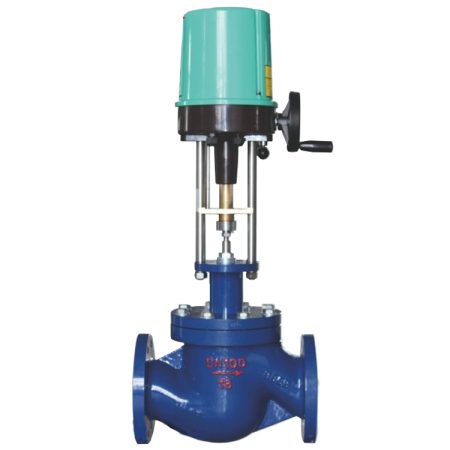
Choosing between an electric vs pneumatic valve actuator depends on your specific requirements. Factors like force, speed, precision, environment, power source, and cost all play a role. Pneumatic actuators provide fast movement and can handle heavy loads, making them ideal for operating a butterfly valve or a ball valve in challenging environments. On the other hand, electric actuators offer superior precision and control, with advanced features such as Ethernet connectivity. The table below compares these options in terms of cost, control, and complexity:
| Factor | Pneumatic Actuators | Electric Actuators |
|---|---|---|
| Cost | Less expensive | More costly, but prices are dropping |
| Capability | Strong force and fast speed | Better precision and control |
| Complexity | Easier to set up | More complex, but becoming simpler |
| Precision & Control | Basic on/off control | Enhanced precision and feedback |
| Application Fit | Well-suited for fast, simple control of butterfly valve and ball valve | Ideal for detailed control and monitoring |
Choosing the right actuator—whether electric vs pneumatic valve actuator—ensures optimal performance and cost savings for your butterfly valve or ball valve applications.
Key Takeaways
- Electric actuators give very accurate valve control. They are easy to use with automation systems. This makes them good for clean and safe places.
- Pneumatic actuators move valves quickly and with strong force. They work well in tough or dangerous areas. Safety is very important in these places.
- Think about what power you have. Electric actuators need steady electricity. Pneumatic actuators need a good supply of compressed air.
- Look at what your job needs for speed, force, and accuracy. Pick the actuator that fits your valve and process best.
- Think about both starting costs and future costs. Electric actuators cost more at first. They save money on energy and repairs later.
- Both actuator types need regular care. This keeps them safe, reliable, and working longer.
- Choose the actuator that matches your valve and environment. This helps stop damage, leaks, or problems when working.
- Use a simple checklist for power, torque, speed, accuracy, environment, safety, and cost. This helps you pick the right actuator with confidence.
Valve Actuators Overview
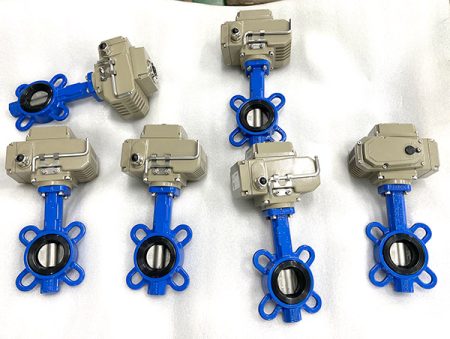
What Are Valve Actuators
A valve actuator is a device that moves a valve open or closed. It acts like the muscle that helps the valve work. Some actuators use electricity, air, or liquid to make the valve move. Others need you to turn a handle by hand. Most new systems use powered actuators because they are faster and more dependable than manual ones.
Role in Automation
Actuators are important for making processes automatic. With actuators, you can control many valves from one control room. This is helpful in big factories where walking to each valve would take too long. Actuators get signals from a control system and move the valve when needed. They help keep things safe by acting fast if something goes wrong. For example, if there is a problem, actuators can close a valve quickly to stop a leak or prevent damage.
Tip: Actuators do more than move valves. They also send back information about where the valve is. This lets you watch your system and find problems early.
Types of Actuators
There are different types of actuators used in factories. Each type uses a special power source and works best in certain jobs.
- Pneumatic actuators use compressed air. They are popular because air is easy to get and safe. You can pick piston, diaphragm, or rotary vane designs.
- Electric actuators use motors to move valves. They are clean and dependable. You use them when you need careful control.
- Hydraulic actuators use liquid pressure, like oil, to make strong force. These are good for big valves or hard work.
- Manual actuators need you to move them by hand. They are simple but not good for high pressure or lots of use.
Actuators also come in two main mechanical types:
- Rotary actuators turn the valve. These work for ball or butterfly valves.
- Linear actuators push or pull the valve stem. These are good for gate or globe valves.
When picking an actuator, think about the power source, the kind of motion you need, and how often you will use it.
Electric Valve Actuators
How They Work
Electric actuators use electricity to move valves. When you send a signal, the actuator starts its motor. The motor uses magnets and coils to work. Electricity flows through the coils and makes a magnetic field. This field pushes on magnets inside the motor. The shaft spins because of this force. The spinning shaft goes into a gearbox. The gearbox changes how fast and strong the shaft turns. This helps the actuator move the valve the right way. Some electric actuators turn the valve. Others push or pull the valve. A control unit inside listens for commands. It tells the actuator how much to open or close the valve. Sensors and switches check where the valve is. They send feedback to your system. This lets you know if the valve is in the right spot. It also helps keep things safe.
Note: Electric actuators work well with PLCs. You can use them for accurate and automatic valve control.
Advantages
Electric actuators have many good points for your system.
- You can control the valve’s position very well.
- They work fast and respond quickly to signals.
- Electric actuators use energy in a smart way. This can save money.
- They are quiet and do not make a mess.
- You can connect them to control systems easily.
- They do not need air compressors or pumps.
- Electric actuators give feedback and have smart features like remote checks.
You can use electric actuators for remote control and automation. You do not need extra devices like pneumatic actuators do. This makes your setup easier to take care of. Electric actuators do not leak or spill because they do not use fluids. They fit well with digital systems and work with many power types.
Disadvantages
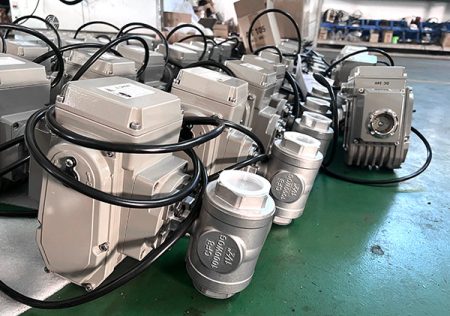
You should know the bad points of electric actuators too.
- They cost more at first because of their parts.
- Electric actuators need steady power. If the power stops, they may not work.
- They can get hot when used, which can wear them out.
- Electric actuators do not make as much force as hydraulic ones.
- You need special skills to set up and program them.
- They may not work well in very hot, dirty, or shaky places.
Tip: Always check if your area is safe for electric actuators before picking them.
When you look at the good and bad points, you see electric actuators are best for clean, safe places where you need accuracy and easy control. But you must plan for their problems, especially in tough spots.
Application Scenarios
Electric actuators are used in many jobs. They help control valves from far away. This makes work safer and faster. When you need to move liquids or gases, electric actuators help you do it right.
Factories use electric actuators for important jobs. In oil and gas plants, they open and close valves on pipes. This lets you control oil or gas flow without sending people into risky places. In chemical plants, electric actuators add the right amount of chemicals at the right time. This keeps things safe and makes sure products are good.
Water and wastewater plants also use electric actuators. They help control water flow, pumps, and treatment chemicals. This keeps water clean and safe. In food and drink factories, you need machines that are clean, quiet, and easy to wash. Electric actuators are good for this. For example, they can control beer flow in a brewery or move food ingredients.
Here is a table that shows where electric actuators are used:
| Industry | Application Example |
|---|---|
| Food and Beverage | Controlling flow in brewing or moving food parts |
| Oil and Gas | Running valves in pipes for safe flow |
| Chemical Processing | Adding chemicals or mixing in water treatment |
| Water & Wastewater | Running pumps and valves in water plants |
You can also find electric actuators in building systems. For example, they help control heating, air, and cooling (HVAC). This keeps buildings comfy and saves energy.
- Food and drink factories like electric actuators because they are clean and quiet.
- Processing plants use them to move materials exactly.
- Robots and machines use electric actuators for accurate moves.
If you need remote control, feedback, and high accuracy, electric actuators are a good pick. They help you automate work, make things safer, and cut down on manual jobs.
Pneumatic Valve Actuators
How They Work
Pneumatic actuators use compressed air to move valves. Air goes into the actuator and pushes a piston or diaphragm. This makes force that opens or closes the valve. Some pneumatic actuators move straight. These work well for gate or globe valves. Others turn the valve. These are good for ball or butterfly valves.
There are two main types of pneumatic actuators:
- Single-acting actuators use air to move the valve one way. A spring pushes it back.
- Double-acting actuators use air on both sides. This moves the valve both ways.
The difference in air pressure makes the valve move. You can pick air-to-open or air-to-close designs. This depends on if you want the valve to fail closed or open when air stops.
Tip: Pneumatic actuators work quickly. They can run many times without getting hot or wearing out fast.
Advantages
Pneumatic actuators have many good points for your system. They move fast and strong because air acts quickly. These actuators are great when you need to open or close valves fast. They last a long time and do not need much care.
Here are some main advantages and disadvantages:
- Pneumatic actuators use clean air. They do not make your process dirty. This is good for food, drink, and medicine plants.
- They cost less and are easy to set up.
- You can use them in hot or cold places.
- Pneumatic actuators are small and light. This helps if you do not have much space.
- They do not get too hot, even with lots of use.
Pneumatic actuators are smart when you want simple, quick, and safe valve control.
Disadvantages
You should know the bad points of pneumatic actuators too. These actuators do not give fine control like electric ones. If you need to set a valve to an exact spot, it can be hard with pneumatic actuators.
Some common disadvantages are:
- Pneumatic actuators need steady compressed air. If air drops or stops, they may not work right.
- Leaks can happen if seals or valves wear out. This can cause safety problems and cost more to fix.
- It is hard to control speed and position very exactly.
- Pneumatic actuators can be affected by temperature, humidity, or tough weather.
- You must check and fix them often to keep them working well.
When you look at the good and bad points, you see pneumatic actuators are best for jobs that need quick, simple moves and clean work. You should plan to check them often and keep your air supply strong.
Application Scenarios
Pneumatic actuator systems are used in many industries. They help you move valves quickly and safely. Factories pick pneumatic actuators for tough places. These places can be dangerous for electric devices.
Here are some ways people use pneumatic actuators:
- Oil and gas plants use pneumatic actuators on pipelines and wellheads. They help control flow and pressure. They keep things safe even if the power goes out.
- Chemical plants use pneumatic actuators on reactors and tanks. They help handle dangerous chemicals. There is no risk from sparks or electric problems.
- Water treatment plants use pneumatic actuators with butterfly valves. They control water flow and pressure in big pipes.
- Petrochemical and refining plants use pneumatic actuators for important valves. They work fast and are very reliable. This is important for safety.
- Industrial plants in risky places use pneumatic actuators. These actuators do not use electricity at the valve. This helps stop fires or explosions.
Tip: Pneumatic actuators can still work if air drops. Some types move the valve to a safe spot if something goes wrong. This fail-safe feature helps you worry less.
You can see how pneumatic actuators are used in this table:
| Industry | Typical Application Example | Why Pneumatic Actuators? |
|---|---|---|
| Oil & Gas | Pipeline and wellhead valve control | Safety, speed, reliability |
| Chemical Processing | Reactor and storage tank valve operation | No spark risk, easy maintenance |
| Water Treatment | Flow control with butterfly valves | Clean, fast, safe |
| Petrochemical/Refining | Critical valve actuation in hazardous areas | Fail-safe, fast response |
You should use pneumatic actuators when you need fast and safe valve moves. They work best where electric devices are not safe. They are also good when you need a simple and strong solution. If your job is in a harsh or risky place, pneumatic actuators are often the best choice.
Electric vs Pneumatic Valve Actuator
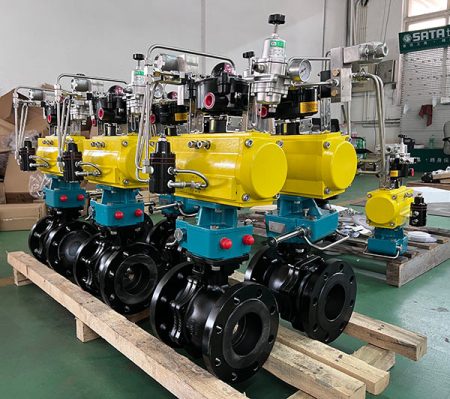
Performance Comparison
When you look at electric vs pneumatic valve actuator, you notice they work differently. You should think about how fast, strong, and accurate you need your valve to be. Electric actuators use motors and gears to move valves. They let you control the valve very exactly. You can set the valve to any spot you want. Some electric actuators can move just a tiny bit, like 0.0001 inches. This is good when you need small changes.
Pneumatic actuators use compressed air to move valves. They move valves quickly and with a lot of force. They can reach speeds up to 2 meters per second. Pneumatic actuators are best for simple open and close jobs. They do not give as much control as electric actuators. Air pressure can change, so the force and position might not always be the same.
Here is a table to help you compare:
| Parameter | Electric Actuators | Pneumatic Actuators |
|---|---|---|
| Force | Precise, repeatable, based on motor torque and gearing | High force, depends on air pressure and piston size, less consistent |
| Speed | Controlled, adjustable, repeatable | Very fast, less precise, depends on air supply |
| Precision & Accuracy | High, can reach 0.0001 inches, holds position well | Lower, mainly for end-to-end moves, affected by air system changes |
| Motion Control | Complex profiles, programmable, multi-point positioning | Simple, usually just open or close, limited control |
Tip: Pick electric actuators if you need exact moves every time. Choose pneumatic actuators if you want fast and strong action.
You should pick electric vs pneumatic valve actuator based on if you need speed, force, or accuracy.
Cost and Maintenance
You need to think about both the first price and future costs when picking an actuator. Electric actuators cost more at the start. You pay for motors, controllers, and wires. Pneumatic actuators cost less at first, especially if you already have an air system.
But that is not the whole story. Electric actuators use less energy, so you save money over time. They have fewer moving parts, so you do not need to fix them much. Pneumatic actuators need regular care. You must check for air leaks, change seals, and keep the air clean and dry. This makes your costs go up.
Here is a table that shows the differences:
| Cost Aspect | Electric Actuators | Pneumatic Actuators |
|---|---|---|
| Initial Purchase | Highest upfront costs | Lower upfront costs |
| Installation | Simple electrical connection | Needs compressed air source |
| Operating Costs | Lower, high energy efficiency | Higher, air compression uses more energy |
| Maintenance & Repair | Low maintenance, fewer repairs | Ongoing maintenance, frequent repairs |
| Replacement Costs | Lower, long lifespan | Moderate, more frequent part replacement |
| Environmental Costs | Minimal, better energy use | Moderate, less efficient, more waste |
- Electric actuators give you better control and need less fixing.
- Pneumatic actuators cost less to buy but need more care over time.
Note: Your choice between electric vs pneumatic valve actuator will affect your budget now and later. Electric actuators save money in the long run, but pneumatic actuators may cost more to keep working.
Safety and Environment
Safety is important when you choose an actuator. You need to think about where you will use it. Pneumatic actuators use air, so they do not make sparks. You can use them in places with explosive gases or dust. They work well in tough places, like very cold or hot factories. Pneumatic actuators use strong materials and coatings to stop rust.
Electric actuators need power to work. You must protect them in dangerous areas. You might need special covers to stop sparks. Electric actuators work best in clean, safe places. They are quiet and do not leak fluids.
Here is a table to help you compare:
| Feature | Pneumatic Valve Actuators | Electric Valve Actuators |
|---|---|---|
| Hazardous Area Suitability | Excellent, no ignition risk | Needs protection, risk of sparks |
| Temperature Range | Wide, -40°C to 80°C | Narrower, -20°C to 60°C |
| Corrosion Resistance | High, with coatings and stainless steel | Good, depends on design |
| Noise Level | Moderate, air exhaust noise | Low, silent operation |
| Environmental Suitability | Best for harsh, extreme conditions | Best for clean, controlled environments |
- Pneumatic actuators are safer in risky places and work in tough spots.
- Electric actuators need extra safety steps in dangerous areas but are quiet.
Alert: Always check your area before picking electric vs pneumatic valve actuator. Pneumatic actuators are safer for places with explosions or chemicals. Electric actuators are better for clean, indoor jobs.
Electric vs Pneumatic Valve Actuator: Summary Table
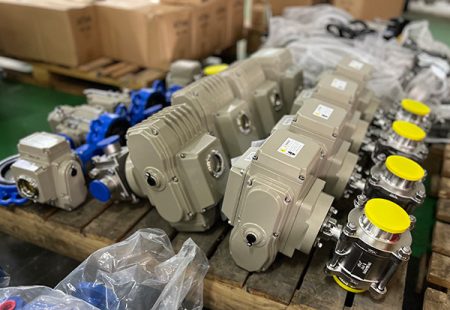
Here is a quick table to help you decide:
| Aspect | Electric Valve Actuator | Pneumatic Valve Actuator |
|---|---|---|
| Speed | Adjustable, precise | Very fast, less precise |
| Force | Precise, repeatable | High, less consistent |
| Precision | High, multi-point | Low, end-to-end |
| Cost | Higher upfront costs, lower long-term | Lower upfront costs, higher maintenance |
| Maintenance | Low maintenance | Ongoing maintenance |
| Safety | Needs protection in hazardous areas | Safer in hazardous areas |
| Environmental Suitability | Best for clean, controlled spaces | Best for harsh, extreme environments |
When to Choose Each Type
- Pick electric vs pneumatic valve actuator for jobs that need careful control, automation, and little fixing.
- Choose pneumatic actuators for fast, strong moves in risky or tough places.
- Electric actuators are best where you want quiet, exact, and steady work.
- Pneumatic actuators work well where you need safety, speed, and simple moves.
Tip: Think about your job, where you will use it, and your budget before you choose. The right actuator helps you save money, stay safe, and get your work done well.
How to Select the Right Actuator
Picking the best actuator for your job can seem hard. You need to match what the actuator does to what your job needs. This part will help you choose step by step. You will learn how to look at your job, see what matters most, and use a checklist to pick the right one.
Assessing Application Needs
Start by looking at your job closely. You want to make sure the actuator you pick will work well and last. Here are some steps to follow:
- Find out the temperature and pressure your system will have.
- Decide if you need the valve to stop at exact spots or just open and close.
- Look at how different actuators work, like pneumatic, electric, or hydraulic.
- Pick the actuator type that fits your needs for speed, force, and control.
- Choose a model that meets your needs for accuracy, repeatability, and how fast it reacts.
You should also:
- Check if you have the right power, like air or electricity.
- Make sure the actuator can move your valve, even if it is hard to turn.
- Think about safety, like if you need it to return to a safe spot by itself.
- Look at where you will put the actuator. Some places need special models that can handle explosions or bad weather.
- Think about how often you will use the actuator and how fast it must move.
- Think about how easy it will be to fix or take care of the actuator.
Tip: Write down what your job needs before you start looking at actuators. This will help you stay on track when picking one.
Key Selection Criteria
When you want to pick the right actuator, you need to look at some important things. Each one changes how well the actuator will work for you.
Torque and Force
You must pick an actuator that can move your valve with the right amount of force. If you pick one that is too weak, it may not move the valve. If you pick one that is too strong, it could break the valve or waste power. Always check how much force your valve needs, even if things change inside the valve.
Speed
Think about how fast you want the valve to move. Pneumatic actuators move very fast and are good for quick jobs. Electric actuators move at steady speeds. Some electric ones let you change the speed for special jobs.
Precision
Precision is important if you need the valve to stop at exact spots. Electric actuators are very good at this and can hold a spot well. Pneumatic actuators can be precise too, but you might need extra parts to help.
Power Source
Check what kind of power you have. Pneumatic actuators need air, usually between 40 and 120 psi. Electric actuators need steady electricity, often 110-115 VAC. Make sure your plant can give the actuator the power it needs.
Environment
Look at where you will put the actuator. Pneumatic actuators are good in places with fire or explosion risk because they do not make sparks. Electric actuators need special covers in these places. Also, check the temperature. Pneumatic actuators can work in more hot or cold places if you use the right parts.
Cost
Cost is always important. Pneumatic actuators usually cost less at first, especially if you already have air. Electric actuators may cost more to buy, but they often need less fixing later. Think about both the first price and what you will pay over time.
Here is a table to help you compare the main things:
| Selection Criteria | Pneumatic Actuators | Electric Actuators |
|---|---|---|
| Power Source Availability | Needs compressed air (40-120 psi) | Needs electrical power (110-115 VAC) |
| Temperature Range | -40 to 250°F with proper seals | -40 to 150°F typical |
| Hazardous Area Suitability | Excellent, explosion-proof | Needs special enclosures |
| Torque and Force | High, good for large valves | Limited by motor size |
| Speed of Actuation | Very fast, adjustable | Fixed or adjustable with controls |
| Precision and Modulating | Needs positioners for high precision | High precision, easy modulating |
| Safety Features | Spring return, can stall without damage | Needs torque switches, battery backup for fail-safe |
| Maintenance Needs | Needs air system upkeep | Lower, no air system needed |
| Cost Implications | Lower actuator cost, air system adds expense | Higher upfront, lower ongoing maintenance |
| Control Integration | Limited, may need extra devices | Excellent, easy with digital systems |
Note: Always match what the actuator can do to what your job needs for the best results.
Selection Checklist
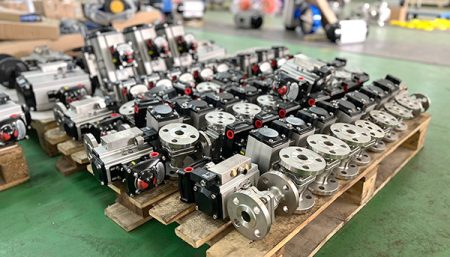
You can use this checklist to help you pick and make sure you do not forget anything:
| Checklist Item | Description & Considerations |
|---|---|
| Power Source | Do you have compressed air, electricity, or hydraulic power available? |
| Valve Type Compatibility | Does your valve need a rotary or linear actuator? |
| Torque and Force | Have you checked the valve’s torque needs under all conditions? |
| Speed Requirements | How fast does the valve need to move? |
| Precision Needs | Do you need exact valve positioning or just open/close? |
| Temperature Range | Will the actuator work in your plant’s temperature extremes? |
| Hazardous Area Suitability | Does the actuator need to be explosion-proof or weather-resistant? |
| Duty Cycle | How often will the actuator operate? |
| Safety Features | Do you need fail-safe options like spring return or battery backup? |
| Maintenance Needs | Can your team handle the required maintenance? |
| Cost | Have you considered both the initial price and long-term expenses? |
| Control Integration | Will the actuator connect easily to your control system (SCADA, PLC, IoT)? |
? Use this checklist when picking your actuator so you do not miss anything important.
If you follow these steps and use the checklist, you will know how to pick the right actuator for your job. This helps you match what the actuator does to what you need, avoid mistakes, and get the best results from your system.
Common Mistakes
Ignoring Environment
You might think any actuator will work in your plant. But the place where you use it really matters. Hot, cold, wet, or dirty places can hurt your actuator. If it gets too cold, seals can get stiff and slow things down. If it gets too hot, oil can break down and seals can stop working. Water and humidity can make metal parts rusty. This can also let sludge build up inside pneumatic actuators. Dust and dirt can get inside and block moving parts. This makes them wear out faster.
Tip: Always check the temperature, humidity, and chemicals in your plant before you pick an actuator.
Here is a table that shows how different things in the environment can hurt actuators:
| Environmental Factor | Impact on Actuator Performance |
|---|---|
| Extreme Temperatures | Seal damage, lubricant breakdown, misalignment |
| Humidity | Corrosion, sludge, inconsistent operation |
| Dust/Particulates | Abrasive wear, clogging |
| Chemicals | Corrosion, seal degradation |
| Vibration | Fatigue, misalignment |
You can help your actuators last longer by using covers and special coatings. You should also check them often. If you do not pay attention to these things, your actuator might break early and cost a lot to fix.
Overlooking Maintenance
Some people forget that actuators need regular care. If you skip maintenance, you can get leaks, breakdowns, or even safety problems. Pneumatic actuators need you to look for air leaks and clean filters. You also need to keep the air dry. If dirt or water gets in, the actuator will wear out faster and lose power. Electric actuators need you to check wires, grease moving parts, and watch for water inside.
Here are some important things you should do to keep actuators working:
- Look at seals, gaskets, and fittings for leaks.
- Change or clean filters to keep everything clean.
- Put grease on moving parts when needed.
- Make sure control valves work right.
- Test battery backups and spring returns if you have them.
Note: Doing regular maintenance helps your actuators work well. It also lets you find small problems before they get big.
If you do not do these things, your actuators may stop working more often. This can cost more money and cause safety problems.
Underestimating Control Needs
You might think just turning the actuator on and off is enough. But many jobs need more than that. If you do not match the actuator to what you need, it may not work well. For example, if you use an on/off actuator but need to control flow exactly, it will not work right. You might also use too few actuators or put them in the wrong places. This makes it hard to control your system.
Some common mistakes are:
- Picking actuators that are not strong or fast enough.
- Forgetting you need feedback or position control.
- Not thinking about future upgrades or more automation.
- Not checking energy and force limits, which can overload your system.
Always write down what you need your actuator to do before you pick one. Think about how much control, speed, and feedback you want.
If you do not think about your control needs, you might need to buy more actuators later. Or you might have to accept that your system does not work as well. This can make things cost more and be harder to run.
Neglecting Long-Term Costs
Many people focus only on the price tag when choosing a valve actuator. You might think saving money at the start is the best choice. However, if you ignore the long-term costs, you could end up spending much more over the life of your system.
When you look at electric and pneumatic actuators, you see big differences in how much they cost to own and run over time. Electric actuators often cost more to buy and install. You pay for the motor, wiring, and control panel. Pneumatic actuators usually have a lower price at first. This can make them look like the better deal. But the story does not end there.
You need to think about what happens after you install the actuator. Pneumatic systems use many parts. You need compressors, filters, dryers, tubing, and fittings. Some systems have up to 23 different components. Each part needs care and can break down. You must check for leaks, replace seals, and keep the air clean. All this work adds up. Pneumatic actuators also need a steady supply of compressed air. Running compressors uses a lot of energy, even when the actuator is not moving. This means you pay more for electricity every month.
Electric actuators work in a simpler way. You only need wiring, a control panel, and sometimes a transformer. Fewer parts mean less can go wrong. Electric actuators do not need air compressors or extra piping. They use power only when they move the valve. This makes them much more energy efficient. Over time, you spend less on repairs and energy bills.
Here is a table to help you compare the long-term costs:
| Factor | Pneumatic Actuators | Electric Actuators |
|---|---|---|
| Initial Cost | Lower | Higher |
| Number of Components | Many (up to 23) | Few (wiring, panel, transformer) |
| Maintenance Needs | High (regular checks, leak repairs) | Low (minimal upkeep) |
| Energy Use | High (compressor runs often) | Low (power used only during movement) |
| Typical Lifespan | Moderate | 15–20 years, very low failure rate |
| Total Ownership Cost | High over time | Lower over time |
Tip: Always look beyond the sticker price. Think about how much you will spend on energy, repairs, and parts over the next 10 or 20 years.
If you choose an electric actuator, you may pay more at first, but you save money later. You do not need to fix it as often, and you use less energy. Most electric actuators last 15 to 20 years and rarely fail. Pneumatic actuators may seem cheaper, but the cost of air, repairs, and lost time can add up fast.
When you plan for the long term, you make smarter choices. You avoid surprise bills and keep your system running smoothly. Always consider the full cost of ownership, not just the price on day one.
Valve Types and Actuator Compatibility
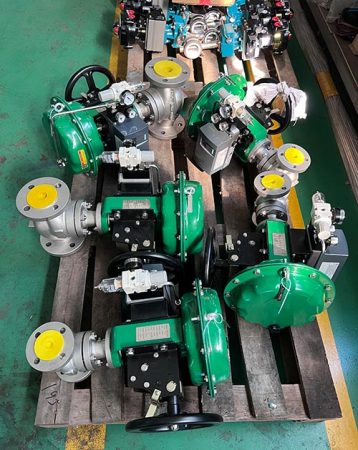
Common Valve Types
Factories use many kinds of valves. Each valve works in its own way. You need the right actuator for each valve. Here are some common valve types you will see:
- Ball valves have a ball with a hole. Turn the ball to start or stop flow. They seal tightly and work for on/off or flow control.
- Butterfly valves use a disc that turns. They are light and fit big pipes. These valves are easy to clean and cost less for large sizes.
- Gate valves use a gate that moves up and down. They are best for fully open or closed jobs. They do not control flow well.
- Globe valves have a plug that moves up and down. These valves help control flow with more precision.
- Plug valves use a plug with a hole. Turn the plug to start or stop flow. Plug valves are simple and good for on/off jobs.
Valves move in two main ways:
- Rotary valves (quarter-turn) like ball, butterfly, and plug valves turn 90 degrees to open or close.
- Linear valves like gate and globe valves move parts up and down.
Here is a table that compares ball and butterfly valves:
| Feature | Ball Valve | Butterfly Valve |
|---|---|---|
| Operation | Rotary quarter-turn; tight seal; good for high pressure and temperature | Rotary quarter-turn; lighter; good for large pipes and lower pressure |
| Flow Control | Good for ON/OFF and modulating; full port means no pressure drop | Good for ON/OFF and proportional; some pressure drop |
| Application | Power plants, oil & gas, refining; handles liquids, gases, solids | Sewage, food, chemical; easy to clean; cost-effective for large sizes |
| Leakage | Tight seal, zero leakage possible | More prone to leakage under high pressure |
| Size & Weight | Heavier, needs more space | Lighter, needs less space |
| Cost | More expensive | More cost-effective |
Tip: Always check your valve type before picking an actuator. The wrong match can cause leaks or damage.
Actuator Suitability for Each Valve Type
Electric actuators: best matches and limitations
Electric actuators fit many valve types. You can use them with ball, butterfly, and globe valves. They give you precise control and feedback. This helps you set the valve to an exact spot. Electric actuators are great for globe valves because they control flow closely. You can use them with ball valves for automation and feedback.
Electric actuators may not be best for very large valves or places with explosion risks. They need steady power and special covers in wet or dirty areas. For gate valves, electric actuators can work, but you must check if they give enough force for linear motion.
Pneumatic actuators: best matches and limitations
Pneumatic actuators work well with rotary and linear valves. You see pneumatic actuated ball valves in oil and gas plants, water treatment, and chemical factories. These actuators move ball valves quickly and with strong force. Pneumatic actuated ball valves are safe in places with explosive gases. You can use them for on/off and simple flow control.
Butterfly valves also match well with pneumatic actuators. The disc design needs less torque, so pneumatic actuators move them fast. Pneumatic actuated ball valves do not give fine control like electric actuators, but they are reliable and safe in harsh places. For gate and globe valves, pick the right linear pneumatic actuator.
Note: Pneumatic actuated ball valves are best for speed, safety, and simple control.
Selection Considerations by Valve Type
Torque and force requirements
Check how much force or torque your valve needs. Ball valves need more torque because of their tight seal. Pneumatic actuated ball valves handle this well, but you must size the actuator right. Butterfly valves need less torque, so you can use a smaller actuator. Gate and globe valves need linear force, so pick an actuator that pushes or pulls with enough strength.
Mounting and interface standards
Make sure the actuator fits your valve. Many valves and actuators follow standards like ISO or API. This helps you match them easily. If you do not check mounting, you may have trouble installing the actuator or keeping it tight.
Cycle frequency and speed
Think about how often you move the valve. Pneumatic actuated ball valves can cycle many times a day without getting hot. Electric actuators may need a break if used too much. Butterfly valves also work well with fast cycling, especially with pneumatic actuators.
Environmental and safety factors
Look at where you use the valve and actuator. If you have explosive gases or dust, pneumatic actuated ball valves are safer because they do not make sparks. For wet, dirty, or hot places, pick actuators with the right coatings and seals. Electric actuators need extra protection in harsh spots.
?? Common Pitfall: Some people pick an actuator too small for a large ball valve. This can make the actuator fail or the valve stick. Always add a safety margin to your torque calculation.
Real-world tips for reliable operation
- Always size the actuator for worst-case pressure and temperature.
- Use standard mounting kits to avoid leaks and misalignment.
- For pneumatic actuated ball valves, check your air supply often.
- For electric actuators, protect them from water and dust with enclosures.
- Test the actuator and valve together before installing them.
Tip: Good planning and the right match between actuator and valve help you avoid breakdowns and keep your system running smoothly.
Control Differences Between Electric and Pneumatic Actuators
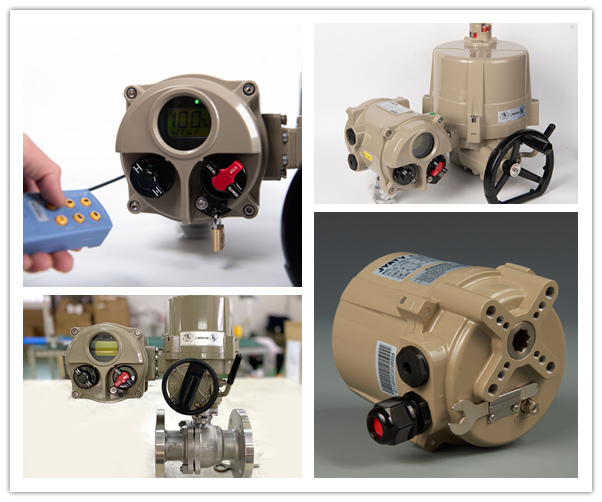
Control Methods
Types of control signals
Electric actuators use signals from computers or panels. These signals can be digital or analog. You can tell the actuator to move to a certain spot. The motor inside listens and moves the valve. You can program electric actuators for many positions.
Pneumatic actuators use air pressure to work. You change the air to move the actuator. Most just turn the valve on or off. Some can do more, but you need extra parts called positioners.
- Electric actuators: Get signals for many moves and can be programmed.
- Pneumatic actuators: Use air to move, mostly for simple open or close jobs.
Modulation and feedback options
Electric actuators give you lots of feedback. You can see where the valve is at any time. Sensors inside send data to your system. This helps you watch how things work and find problems early.
Pneumatic actuators can give feedback too, but you need more sensors. The feedback is not as detailed. You may only know if the valve is open or closed.
Tip: Electric actuators help you watch and change valve moves for careful jobs.
Precision and Responsiveness
Positioning accuracy
Electric actuators are very accurate. You can set the valve to a tiny spot. This is good when you need careful flow control. They can repeat moves without mistakes.
Pneumatic actuators are less accurate. They are best for simple open or close moves. If you want better control, you need a positioner. Even then, they are not as exact as electric actuators.
Response time
Pneumatic actuators move very fast. Air makes them open or close in seconds. This is helpful in emergencies or when you need quick changes.
Electric actuators move slower than pneumatic ones. The motor takes time to get to the right spot. For most jobs, this is fine, but not for super fast needs.
| Aspect | Electric Actuators | Pneumatic Actuators |
|---|---|---|
| Positioning | Very accurate, many spots | Simple, needs help for more |
| Response Time | Medium speed | Very fast |
Integration with Automation Systems
Compatibility with digital controls
You can connect electric actuators to modern systems. They work with computers, PLCs, and smart devices. You can control them from far away and automate tasks. Electric actuators fit well in networked setups.
Pneumatic actuators need air to work. This makes it harder to connect them to digital systems. Newer pneumatic actuators use smart sensors, but they still need air.
Ease of remote monitoring and diagnostics
Electric actuators let you check them from anywhere. You can see their status, run checks, and change settings. This helps you fix problems fast and keep things working.
Pneumatic actuators can be checked too, but you need more sensors. You may not get as much info or control as with electric actuators.
Note: Electric actuators make remote control and automation easy. Pneumatic actuators are getting better with smart tech, but electric ones are still easier for advanced systems.
Application Differences Between Electric and Pneumatic Actuators
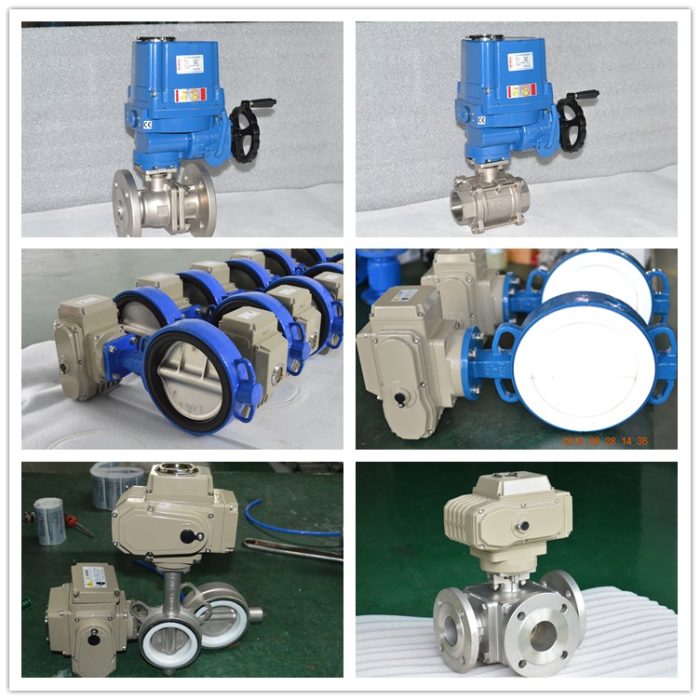
Typical Industries and Use Cases
Industries favoring electric actuators
Electric actuators are used in places that need careful control. Water plants use them to manage flow and add chemicals. Food factories pick electric actuators because they are clean and simple to use. Drug factories also use them to follow strict safety rules. Electric actuators work well when you need feedback and remote checks. If you want to make small changes or use digital controls, electric actuators are a good choice.
Industries favoring pneumatic actuators
Pneumatic actuators are found in places that need quick and safe moves. Oil and gas companies use them on pipes and wells. Chemical plants use pneumatic actuators to handle risky materials. Power plants and refineries also use them. These places often have air systems ready. Pneumatic actuators are good for jobs that need fast action but not exact control. If your work is in a dangerous spot, pneumatic actuators are safer.
Suitability for Specific Operating Conditions
High-precision and automation requirements
Pick electric actuators if you need exact moves. They let you set the valve to a tiny spot. Electric actuators connect to automation easily. You can program them for special moves and get feedback. This makes them great for labs, factories, and water plants.
Hazardous or explosive environments
Pneumatic actuators are best where there is fire or explosion risk. They do not make sparks, so they are safe near gas or dust. Oil and chemical plants trust pneumatic actuators for this reason. If you need a system that goes to a safe spot when air drops, pneumatic actuators can do that.
Remote or off-grid locations
Sometimes you need to control valves far away from power. Pneumatic actuators work well if you have air. They do not need electricity, so they keep working if the power goes out. For remote pipes or tanks, pneumatic actuators are simple and reliable.
Tip: Always pick an actuator that fits your job. Think about where you use it, how much control you need, and what resources you have.
Real-World Application Examples
Electric Actuator Cases
Electric actuators are used in water treatment plants. For example, a city uses them to control water and chemicals. Workers set valve positions from a control room. The actuators move valves to the right spot. This keeps water clean and safe for everyone.
In food factories, electric actuators are on mixing tanks. Workers use computers to change the valves. The actuators open and close slowly and carefully. This keeps the mix correct and stops spills. You also see electric actuators in big building HVAC systems. They help control air flow and temperature. This makes the building comfortable for people.
Tip: Electric actuators are good for careful control and feedback. You can use them to automate many valves at once.
Pneumatic Actuator Cases
Pneumatic actuators are found in oil refineries and chemical plants. In one refinery, workers use them to open and close pipeline valves. These actuators move very fast to stop leaks or fires. You also see pneumatic actuators in wastewater plants. They control big butterfly valves for dirty water flow. The actuators keep working if the power goes out, as long as there is air.
In paint factories, pneumatic actuators move thick liquids in pipes. They do not spark, so they are safe near flammable chemicals. You can trust pneumatic actuators where safety and speed are important.
Note: Pneumatic actuators are good for tough jobs in risky places. They work in harsh weather and dangerous spots.
Lessons Learned
Always match the actuator to your job. Electric actuators give great control and feedback. They work best in clean, safe places for exact valve moves. Pneumatic actuators move fast and handle tough conditions. You can use them where there is fire or explosion risk.
Here are some lessons to remember:
- Check your power source before picking an actuator.
- Think about how much control you need.
- Look at the environment and safety needs.
- Plan for both first cost and upkeep cost.
Remember: The right actuator helps your system work better, saves money, and keeps people safe.
When picking between electric and pneumatic actuators, think about what your job needs. You should look at how much force, speed, and accuracy you want. Also, check if your workplace is clean or rough, and how much money you can spend.
- Electric actuators let you control things very exactly and make it simple to use machines from far away.
- Pneumatic actuators are good when you need things to move fast and strong, especially in hard or dirty places.
Always look over your system and ask an expert for help if your job is tricky or very important. Picking the right actuator helps your work stay safe and run well.

FAQ
What is the main difference between electric and pneumatic actuators?
Electric actuators use motors and electricity to move valves. Pneumatic actuators use compressed air instead. Electric actuators let you control valves more exactly. Pneumatic actuators move valves faster and work well in rough places.
Can you use electric actuators in hazardous areas?
Electric actuators need special covers in dangerous spots. They might make sparks that can be risky. Pneumatic actuators are safer where there are explosive gases or dust. This is because they do not use electricity at the valve.
How do you know which actuator fits your valve?
Look at your valve’s type and size first. Ball and butterfly valves usually need rotary actuators. Gate and globe valves need linear actuators. Always make sure the actuator’s force and movement match what your valve needs.
Do electric actuators need a lot of maintenance?
Electric actuators do not need much care. You should check wires and keep them clean. Pneumatic actuators need more checks for air leaks and worn seals.
What happens if the power or air supply fails?
If power goes out, electric actuators stop working. Some have batteries to help in this case. Pneumatic actuators can use springs to move valves to a safe spot if air stops.
Are pneumatic actuators more cost-effective?
Pneumatic actuators cost less to buy at first. But you pay more later for fixing air leaks and keeping the system running. Electric actuators cost more at the start but save money on repairs and energy.
Can you control actuators from a computer?
You can connect electric actuators to computers easily. This lets you control them from far away. Pneumatic actuators need extra parts for feedback and control. Electric actuators are better for automation and remote checks.
Which actuator is best for fast valve movement?
Pneumatic actuators move valves very fast. Pick them if you need quick action. Electric actuators move slower but give you better control.
Tip: Always think about what your job needs before picking an actuator. The right choice helps your system work well and last longer.
